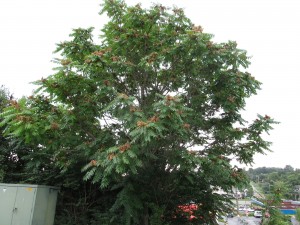Tree of heaven (Ailanthus altissima) is a hated tree and tagged noxious and invasive across the U.S. (USDA hardiness zones 4 to 8). This aggressive species is indigenous to China and seems almost without limits as to where it takes root across the U.S. It has numerous nicknames, including “trash can tree”. It is the tree featured in the 1943 book and 1945 movie “A Tree Grows In Brooklyn” (tree has little to do with the story).
The tree grows in a wide range of soils including poor ones, on sites where few other trees would prosper. It prefers full sun, but can cope with shady environs. Roots sucker freely and can form large colonies or thickets. It grows almost anywhere, even from the cracks in concrete sidewalks or asphalt parking lots. It also self-seeds freely. Across the U.S. tree of heaven grows along roads and fencerows.
Tree of heaven exhibits a lush tropical look; its pinnate compound leaves are 1 to 4 feet in length. Growth rate is an incredible 3-5 feet annually, eventually 40-60 feet tall and 30-40 feet spread and a loose, open canopy. Tree grows shorter in urban areas.
Its foliage is highly resistant to air and ground pollutants very common in large urban areas. Its leaves help to purify the air and cool the planet. Its shade (cooling) value worldwide has been estimated as 0.5 of 1º F. Serious insect or disease problems do not exist.
Plant scientists need to research this species. Its rapid growth rate might be harnessed for green biomass as a future biofuel resource. Perhaps, its invasive nature could be reined in. Little research work has been done to find or breed a sterile form.
Its root suckering is quite variable among the Ailanthus population. Some trees sucker very little.


 Posted in
Posted in 
